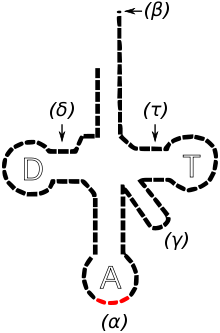D arm
The D arm is a feature in the tertiary structure of transfer RNA (tRNA). It is composed of the two D stems and the D loop. The D loop contains the base dihydrouridine, for which the arm is named.[1] The D loop's main function is that of recognition. It is widely believed that it acts as a recognition site for aminoacyl-tRNA synthetase, an enzyme involved in the aminoacylation of the tRNA molecule.[1][2] The D stem is also believed to have a recognition role although this is yet to be proved.
It is a highly variable region and is notable for its unusual conformation due to the over-crowding on one of the guanosine residues. It appears to play a large role in the stabilization of the tRNA's tertiary structure.
References
- 1 2 Hardt, Wolf Dietrich; Schlegl, Judith; Erdmann, Volker A.; Hartmann, Roland K. (December 1993). "Role of the D arm and the anticodon arm in tRNA recognition by eubacterial and eukaryotic RNase P enzymes". Biochemistry. 32 (48): 13046–13053. doi:10.1021/bi00211a014. Retrieved 23 November 2014.
- ↑ Smith, Drew; Yarus, Michael (April 1989). "Transfer RNA structure and coding specificity". Journal of Molecular Biology. 206 (3): 489–501. doi:10.1016/0022-2836(89)90496-8. Retrieved 23 November 2014.
This article is issued from
Wikipedia.
The text is licensed under Creative Commons - Attribution - Sharealike.
Additional terms may apply for the media files.
